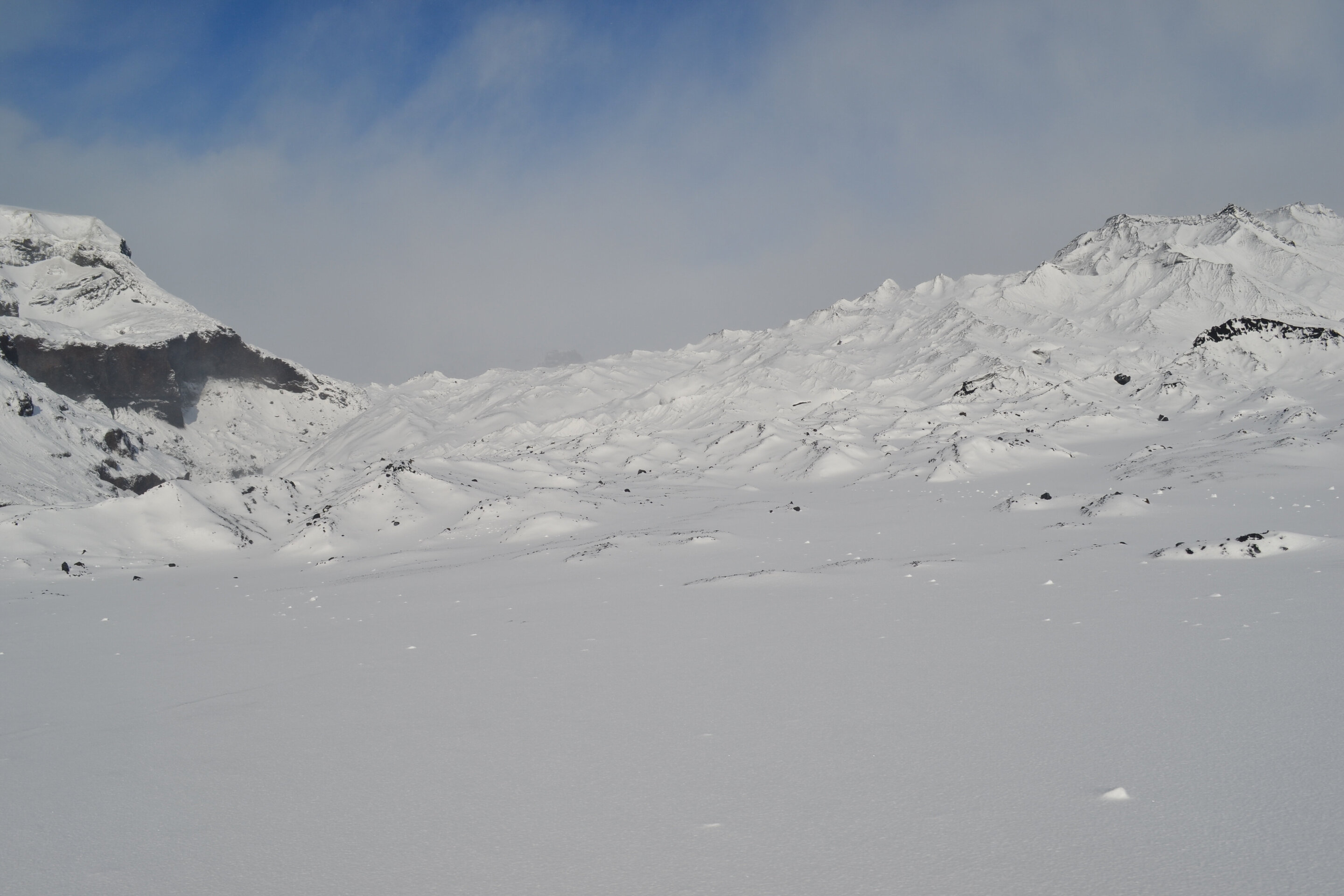

The fourth largest glacier in Iceland, Kötlujökull is home to abundant microorganisms supported by hydrogen produced by the weathering of basalt rock. Credit: Eric S. Boyd.
Using years of data collected from ice-covered habitats around the world, a team from Montana State University has uncovered new insights into the processes that support microbial life beneath ice sheets and glaciers, and the role these organisms play in perpetuating live through ice ages and perhaps in seemingly inhospitable environments on other planets.
PhD candidate Eric Dunham from MSU’s Department of Microbiology and Immunology in the College of Agriculture, along with mentor Eric Boyd, published their findings in the journal Proceedings of the National Academy of Sciences this week. The work examines the ways in which water and microbes interact with the rock beneath glaciers, using samples of sediment from glacier sites in Canada and Iceland.
“We kept finding organisms in these systems that were supported by hydrogen gas,” Boyd said of the inspiration for the project. “At first it was wrong, because we couldn’t find out where that hydrogen gas came from under these glaciers.”
A team of researchers, including Boyd, later discovered that a series of physical and chemical processes produce hydrogen gas by crushing the silica-rich rock beneath glaciers into tiny mineral particles by the weight of the ice on them. When those mineral particles combine with ice melt water, they release hydrogen.
What became even more fascinating to Boyd and Dunham was that microbial communities beneath the glaciers could combine that hydrogen gas with carbon dioxide to generate more organic matter called biomass through a process called chemosynthesis. Chemosynthesis is similar to how plants generate biomass from carbon dioxide through photosynthesis, although chemosynthesis does not require sunlight.
-

Graduate student Eric Dunham from Montana State University. Credit: Montana State University
-

A primary melt water stream from the Kötlujökull glacier, Iceland. Credit: Eric S. Boyd.
To learn more about what those chemosynthetic microbes were doing, Dunham used samples of sediment from the glaciers in Canada and Iceland. He grew samples of the living organisms found in the sediment in a lab and watched them for several months to see if they would continue to grow in the simulated environment.
“The organisms we were interested in rely on hydrogen gas for food to grow, and most are also anaerobic, meaning oxygen will kill them,” said Dunham, who is originally from Billings and is entering the final semester of his PhD. “One of the most critical steps in preparing for these experiments, and easily the most stressful element, was to bottle those samples and flush out all the oxygen as quickly as possible, so I didn’t have the organisms I was trying to study. killed. “
After months of preparation and observation of the microbial cultures, Dunham discovered that it was not only possible to monitor the growth of the communities in the laboratory environment, but also that the type of rock beneath a glacier affected how much hydrogen gas was produced, which means in turn, led to the presence of microbial communities that were better adapted to metabolize hydrogen. Samples taken from Iceland’s Kötlujökull Glacier, which sits atop basalt rock, produced much more hydrogen gas than the samples taken from the Robertson Glacier in Alberta, Canada, which has a carbonate bottom underneath.
While they use that hydrogen gas to generate energy, Boyd said, the microbes also extract carbon dioxide from the air to create, replicate, and grow biomass. That ability to “fix” carbon is a crucial climate regulation process, another similarity to photosynthesis in plants.
Given that glaciers and ice sheets cover about 10% of Earth’s landmass today, and sometimes a much larger fraction of the planet’s past, microbial activities like the one Eric measured have likely had a major impact on the climate on earth. today and in the past, ”said Boyd. “We’ve known for a while that microorganisms that live under ice sheets or glaciers can capture carbon, but we’ve never really understood how. solid carbon, they also don’t need sunlight to do it, like the rest of the biosphere we know. “
Looking further at the other planets in our solar system, Boyd notes that two of the crucial elements that scientists look for when evaluating habitability are water and an energy source. The newfound knowledge that self-sustaining microbial communities can thrive in frigid environments through hydrogen gas production is a critical step toward identifying potentially habitable environments on other planets.
“There is a lot of evidence for ice and glaciers on other planets,” he said. ‘Are they habitable? We do not know. Could microbes live under ice sheets on planets with rocks similar to the one Eric studied? Absolutely. There is no reason to think otherwise. ‘
For Dunham, whose undergraduate and post-baccalaureate research focused on health sciences and virology before moving to biogeochemistry, the most rewarding part of the new discovery is examining how different Earth processes fit together and influence each other in ways that scientifically understand. community is just beginning to open up.
Between a rock and a hard place: how life survives under a glacier
Lithogenic hydrogen supports microbial primary production in subglacial and proglacial environments PNAS; doi.org/10.1073/pnas.2007051117
Provided by Montana State University
Quote: Researchers Find Hydrogen-Assisted Life Among Glaciers (2020, December 22) Retrieved December 22, 2020 from https://phys.org/news/2020-12-hydrogen-supported-life-beneath-glaciers.html
This document is protected by copyright. Other than fair treatment for the purposes of private study or research, no part may be reproduced without written permission. The content is provided for informational purposes only.